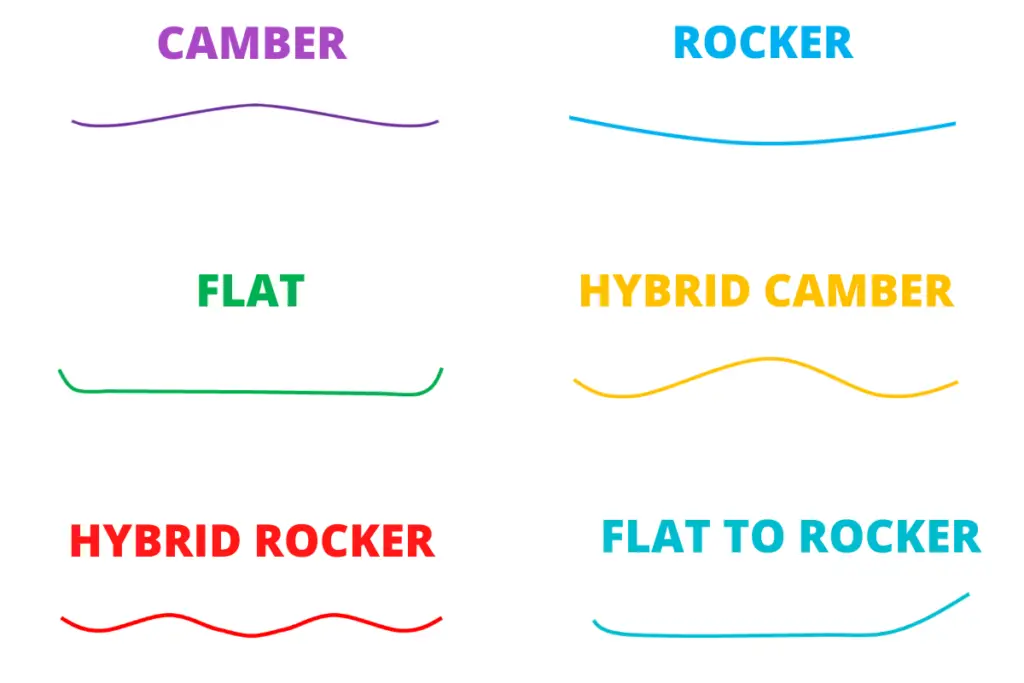There are many types of snowboard camber profiles available, and one of the more popular is the zero-camber (also known as flat) profile. In this article I’ll explain exactly what a zero camber snowboard is and the pros and cons of this profile type.
Zero Camber (Flat) Snowboard 101
There are several types of snowboard camber profiles available. The camber profile refers to the curvature of the board when it is on flat group and viewed from side-on. Traditional camber profiles have
Zero camber snowboards are also referred to as flat snowboards. Unlike most other camber profile types, the board has much more contact with the snow because it does not have any rocker or camber sections.
Zero camber (flat) snowboards feel stable, good in powder and are suitable for beginners. However, the drawbacks of zero camber snowboards are that they can feel a bit lifeless compared to camber profiles which have more pop and they are more likely to catch an edge compared to rocker profiles.

In reality, although these types of snowboards are referred to as “flat”, there is typically some slight camber/ rocker to them but not enough for them to be considered rocker or camber boards.
Advantages of Zero Camber (Flat) Snowboards
- Increased contact with the snow makes them feel more stable
- Provide good edge hold
- Suitable for beginners
- Suitable for most styles and terrains
The main overall advantage of a zero camber (flat) snowboard is that it is a good all-rounder. Going from edge to edge on powder feels fast on a flat board and it can be used for powder and park snowboarding and provides a good level of edge hold.
Disadvantages of Zero Camber (Flat) Snowboards
- Can feel slow
- Not very lively
- Some susceptibility to edge catching
The main drawback of a zero camber board is that is feels quite slow because there is a lot of contact with the snow underneath it, hence it is not recommended for racing.
Since flat boards are quite versatile overall and work well in most conditions they are often described as being a “jack of all trade and master of none”. They provide a good level of edge hold, but they don’t match camber and hybrid camber profiles in terms of grip.
Sometimes zero camber boards are described as being a bit boring and not lively enough for some riders, particularly those who have come from traditional camber or hybrid camber boards.
Although they are a good option for beginners, some may find that they catch an edge with this type of snowboard. Catching an edge is when a snowboarder is tripped up by the front edge of the board when it gets caught in the snow. This is less likely to happen with a rocker (reverse camber) profile.
Comparison to Other Camber Profile Types

Flat to Rocker
A flat to rocker board profile is flat under the front foot and rocker under the back foot. Flat to rocker profiles are better for powder and less likely to catch an edge so preferred for beginners compared to zero camber (flat) profiles. However, zero camber boards provide more edge grip.
Rocker (Reverse Camber)
Compared to rocker profiles, zero camber (flat) snowboards are more likely to catch an edge so beginners may feel more comfortable with a rocker profile. However, flat snowboards are more stable and provide better edge hold compared to rocker boards.
Hybrid Rocker
Hybrid rocker snowboards are less likely to catch an edge compared to zero camber snowboards. Both types of snowboard are considered to be quite versatile, however flat (zero camber) boards are often more popular for beginners.
Traditional Camber
Compared to traditional camber profiles, zero camber (flat) snowboards are more suitable for beginners and less likely to catch an edge. However, traditional camber profiles will feel more stable at higher speeds, faster and have more pop.
Hybrid Camber
Zero camber (flat) snowboards are better for powder compared to hybrid camber snowboards. However, hybrid camber snowboards are better for high speeds and feel more lively with more “pop” compared to flat boards.

